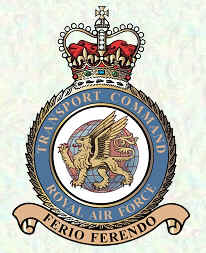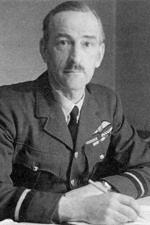
The Desert Air Force (DAF), also known chronologically as Air Headquarters Western Desert, Air Headquarters Libya, the Western Desert Air Force, and the First Tactical Air Force (1TAF), was an Allied tactical air force created from No. 204 Group RAF under RAF Middle East Command in North Africa in 1941 to provide close air support to the British Eighth Army against Axis forces. Throughout the Second World War, the DAF was made up of squadrons from the Royal Air Force (RAF), the South African Air Force (SAAF), the Royal Australian Air Force (RAAF), the United States Army Air Forces (USAAF) and other Allied air forces.

The former Royal Air Force Far East Air Force, more simply known as RAF Far East Air Force, was the Command organisation that controlled all Royal Air Force assets in the east of Asia. It was originally formed as Air Command, South East Asia in 1943 during the Second World War. In 1946, this was renamed RAF Air Command Far East, and finally Far East Air Force in June 1949.

The RAF Second Tactical Air Force (2TAF) was one of three tactical air forces within the Royal Air Force (RAF) during and after the Second World War. It was made up of squadrons and personnel from the RAF, other British Commonwealth air forces, and exiles from German-occupied Europe. Renamed as British Air Forces of Occupation in 1945, 2TAF was recreated in 1951 and became Royal Air Force Germany in 1959.

RAF Transport Command was a Royal Air Force command that controlled all transport aircraft of the RAF. It was established on 25 March 1943 by the renaming of the RAF Ferry Command, and was subsequently renamed RAF Air Support Command in 1967.

Air Chief Marshal Sir William Alec Coryton, was a senior Royal Air Force (RAF) commander in World War II. He was considered by his peers as one of the RAF's most capable group commanders.

No. 13 Group was a group in the Royal Air Force for various periods in the 20th century. It is most famous for having the responsibility for defending the North of the United Kingdom during the Battle of Britain.

No. 1 Group of the Royal Air Force is one of the two operations groups in RAF Air Command. Today, the group is referred to as the Air Combat Group, as it controls the RAF's combat fast-jet aircraft and has airfields in the UK, as well as RAF Support Unit Goose Bay at CFB Goose Bay in Canada. The group headquarters is located alongside Headquarters Air Command at RAF High Wycombe, Buckinghamshire. The other operational group is No. 2 Group RAF.
Battle Honours are awarded by the Sovereign to Royal Air Force squadrons to commemorate the squadron's role in a particular operation.

No. 3 Group of the Royal Air Force was an RAF group first active in 1918, again in 1923–26, part of RAF Bomber Command from 1936 to 1967, and part of RAF Strike Command from 2000 until it disbanded on 1 April 2006.

The Australian First Tactical Air Force was formed on 25 October 1944 by the Royal Australian Air Force (RAAF). Its purpose was to provide a mobile force of fighter and ground attack aircraft that could support Allied army and naval units fighting the Empire of Japan in the South West Pacific Area. One of several Allied tactical air forces formed during World War II, it evolved from the RAAF's No. 10 Operational Group, established a year earlier. Following action in the assaults on Aitape and Noemfoor, the group was renamed the First Tactical Air Force to better reflect its size and role. It was beset with morale and leadership issues in early 1945, but recovered to take part in the battles of Tarakan, North Borneo, and Balikpapan. Reaching its peak strength of over 25,000 personnel in July 1945, No. 1 TAF's squadrons operated such aircraft as the P-40 Kittyhawk, Supermarine Spitfire, Bristol Beaufighter, and B-24 Liberator. The formation remained active following the end of hostilities in the Pacific until it was disbanded on 24 July 1946.

Air Chief Marshal Pratap Chandra Lal, DFC was the Chief of Air Staff (CAS) of the Indian Air Force during the Indo-Pakistan War of 1971. He served in the IAF from 1939 until his retirement in 1973. He was the CAS at the time of Operation Chengiz Khan, the preemptive strikes that were carried out by the Pakistan Air Force (PAF) that marked the formal initiation of hostilities of the Indo-Pakistani War of 1971.

No. 355 Squadron RAF was a long-range bomber squadron based in British India from August 1943 until it disbanded in May 1946. Raised for service during the Second World War, the squadron was equipped with Consolidated Liberator aircraft and carried out operations against the Japanese during the Burma campaign.
No. 6 Squadron (Dragons) is a fighter squadron and is equipped with Jaguar IM/IS and based at Jamnagar Air Force Station.

Dinjan Airfield, also known as Dinjan Air Force Station, is an air base of Indian Air Force. Established as an air field in World War II, it is located in Dinjan, approximately seven miles northeast of Chabua, in the state of Assam, India.
No. 273 Squadron RAF was a Royal Air Force squadron formed as reconnaissance unit in World War I, and re-formed in World War II in Ceylon - initially as a torpedo bomber and reconnaissance unit. In mid 1944 the squadron was re-equipped with Spitfire Mk VIIIs and flew and fought out of airfields in India and Burma. Following the end of the war, the squadron was moved first to Siam (Thailand), and then later, French Indo-China (Vietnam). It was re-equipped with Spitfire Mk XIVs in November 1945.

Air Marshal Ramaswamy Rajaram, DFC (1917–1969) was a senior officer in the Indian Air Force. He died in harness while serving as the Vice Chief of Air Staff (VCAS) of the Indian Air Force. He was the Air Officer Commanding-in-Chief Western Air Command during the Indo-Pakistani War of 1965.
RAF India, later called Air Forces in India (1938–47) was a command of the Royal Air Force (RAF) that was active from 1918 until Indian independence and partition in 1947. It was the air force counterpart of the British Army in India.
Air Vice Marshal Ranjan Dutt, VrC was a former air officer of the Indian Air Force. He last served as the Air Officer Commanding-in-Chief Eastern Air Command. Prior to that, he was the managing director of Hindustan Aeronautics Limited.















